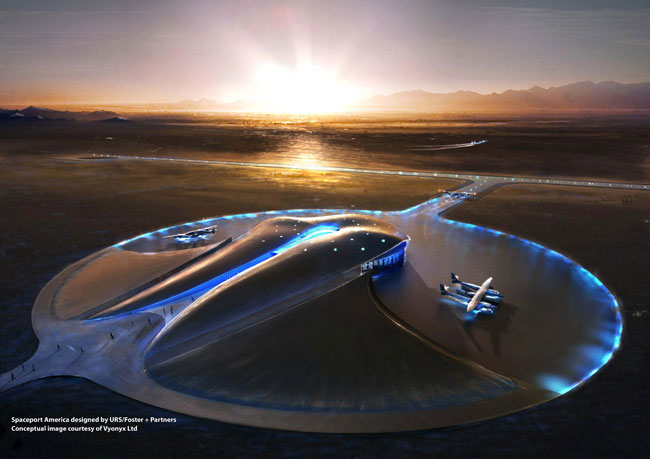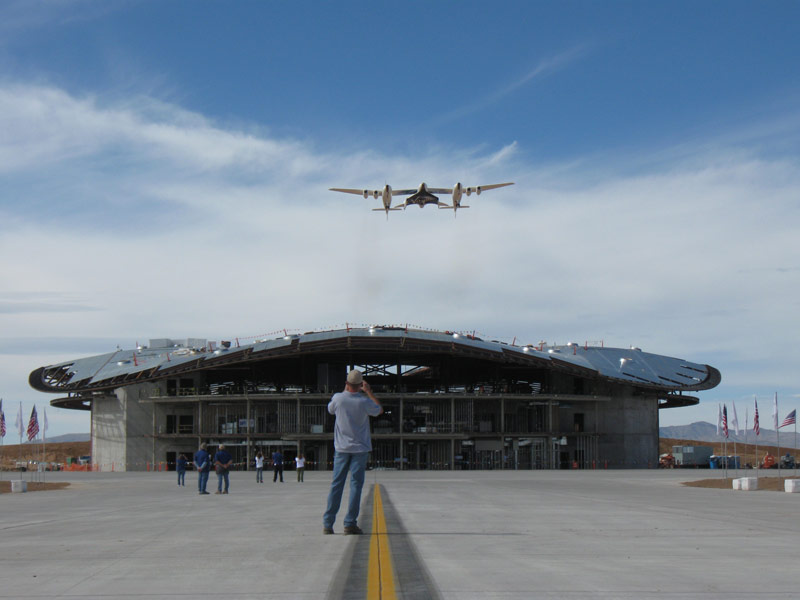
Spaceport's Construction Heralds Era of Commercial Space Travel

LAS CRUCES, N.M. — Spaceport America is billed as the world’s first purpose-built commercial spaceport.
Under construction roughly 45 miles north of Las Cruces on a remote desert landscape, the 18,000-acre Spaceport America site sports a nearly two-mile long, 200–foot-wide “spaceway” that can handle the suborbital traffic flow of pay-per-view space tourists using anchor tenant Virgin Galactic and its WhiteKnightTwo/SpaceShipTwo system.
A futuristic-looking terminal hangar is nearly complete, adding to the facility’s space-age ambiance. But another vibe is in the air – a “build it and they will come” optimism, but one that also has its fingers crossed for good luck. [Photos: Spaceport America Blooms in N.M. Desert]
“The spaceport Phase 1 construction work is now 90 percent done and the first phase is on schedule to be done by the end of 2011,” said David Wilson, head of Spaceport America Media Relations here in Las Cruces.
Wilson said that Phase I construction is made up of the spaceport’s large runway, which is completed, the terminal hangar facility that Virgin Galactic will use, the internal roads, fencing, electrical system, water/sewer systems and the dome-looking Space Operations Center.
Phase II construction, on which planning has already begun, is made up of the final build-out of the Vertical Launch Complex facility, the visitor/welcome centers in the neighboring towns of Truth or Consequences and Hatch and a visitor area on the main spaceport campus. The southern road from interstate I-25 to the spaceport is also part of Phase II construction.
Phase II is projected to be completed in 2013, after which time the spaceport becomes fully operational, Wilson said.
Get the Space.com Newsletter
Breaking space news, the latest updates on rocket launches, skywatching events and more!

Meet the new boss
Christine Anderson is the newly appointed executive director of the New Mexico Spaceport Authority.
Before retiring from 30 years in civilian positions with the U.S. Air Force, Anderson held director titles at the Air Force Research Laboratory, Kirtland Air Force Base in New Mexico,the Air Force Phillips Laboratory at Kirtland, the Military Satellite Communications Joint Program Office at the Air Force Space and the Missile Systems Center in Los Angeles.
In taking on her new job, Anderson met the challenges associated with the New Mexico legislature slashing the spaceport office budget by 57 percent. She plans to follow a process for requesting a restoral of funding.
Meanwhile, the overall spaceport development budget of $209 million is intact.
Tomorrowland landscape
As a visitor at Spaceport America, you can take in the Tomorrowland-looking terminal hangar, the spaceport operations center, water treatment and fuel storage facilities, vertical launch pads, along with the lengthy runway.
“When you think about what a feat that is, to build all that anywhere, but then to build it in the middle of the high desert in New Mexico — that’s a small city that was built. So hats off to all the contractors and architects and everybody else that spent a lot of time and sweat equity in its development,” Anderson said in an exclusive SPACE.com interview. “I’m really jazzed about it.”
Anderson said she isn't sure as to when the operational date will be for Spaceport America. Given the ongoing testing of the Virgin Galactic WhiteKnightTwo/SpaceShipTwo launch system, she said it’ll be up to them when they consider it safe to fly the first tourists up to the edge of space.
Anderson said she’s eyeing the first quarter of 2013, but added that it’s a “best guess” date. “That’s sort of my working date that I’m planning.”
On-the-job surprises
A new twist to the Spaceport America story is the prospect of a high-end hotel being built in proximity to the site.
“Virgin is looking into that, for passengers, their friends and family. I’m sure there will be some other hotels springing up because, hopefully, there will be other industries that come into the area, along with more tourists,” Anderson said. “But I’m not getting into the hotel business. I’ve got my hands full with 18,000 acres of spaceport.”
There have already been some early on-the-job surprises, Anderson said. For one, the desert landscape of Spaceport America has proven to be a boon to archaeologists.
“There’s been some fabulous finds in the archaeological mitigation we’re doing,” Anderson said, with more than 20 sites found that point to Paleo-Indians living in the area more than 10,000 years ago.
“It was much more vegetated out in that area back then for those hunter-gatherers,” Anderson pointed out. “That was so unexpected to me. I never worked on that in my space career. Who would have thought with a spaceport you’d be doing that,” she added.
Those archaeological finds will be part of the spaceport’s visitor experience, on display for all to see.
Rise of commercial space
In scoping out what activities can take place at Spaceport America, Anderson is enthusiastic about the suborbital market.
“When I was at the Air Force Research Laboratory, we were always looking for rides…to do experiments and mature technologies. It’s a catch-22 in that you have to have the flight background, the history, in order to get used in the acquisition community. So you’ve got to get some rides somewhere. You can tell a lot from suborbital research,” Anderson noted, “and Spaceport America is a great place to fly from.”
Anderson embraces the rise of commercial space.
“We’ve spent 50 to 60 years, whether you were with NASA or in the military space side, developing all these fabulous technologies that now can be used in the commercial industry,” Anderson said. “All that investment that went on is allowing the commercial side now to flourish…and that’s a good thing. I don’t see a downside to any of that.”
What futuristic upshots could stem from Spaceport America?
Anderson doesn’t discount the emergence of point-to-point passenger travel. “Who knows? I don’t know how it will go 100 years from now, 50 years from now, or is it 25 years from now? I would hope that we’d have some point-to-point spaceflights for commercial passengers. It would be great to go long distances in 30 or 45 minutes.”
For pessimists that see Spaceport America more a white elephant than a busy hub for outgoing and incoming travelers, Anderson responded: “I wonder if they said that about the first airport? I just betcha.”
Challenges ahead
Herb Bachner, an aerospace consultant specializing in commercial space transportation, senses that Spaceport America is likely to attain longevity – but added there are some upfront challenges.
First of all, the people in New Mexico — and especially the two counties that voluntarily increased their taxes to support Spaceport America’s construction — have viewed the project as something that will expand tourism, on the ground, not just in space, Bachner said, as well as contribute to business and engineering activities in southern New Mexico.
There are several challenges ahead, Bachner told SPACE.com, such as resolving issues surrounding the completion of the spaceport.
“As the project comes closer to completion, interested parties will better understand the impact of the new spaceport. The Environmental Impact Statement calls for a significant amount of coordination and planning with local parties and federal authorities. This becomes more important as the project comes closer to completion and initial operation,” Bachner said.
Final configuration
There’s also the issue of negotiating a date when Virgin Galactic will arrive on site and pay rent.
“The development of SpaceShipTwo appears to be moving forward, but there is quite a bit of testing left to do,” Bachner added. For one, it will take time to complete current testing programs, integrate the SpaceShipTwo with the rocket engine, and test the vehicle in its final configuration, he said.
“It is also necessary to develop operational procedures and train spaceport security and operations staff. And of course, the new Terminal Hangar Facility needs to be completed to provide a comfortable environment for both astronauts and visitors. I would think that these are some of the considerations that will go into determining when Virgin Galactic moves to Spaceport America,” Bachner said.
Thirdly, there’s the challenge of establishing Spaceport America as a tourist destination in Southern New Mexico. “This achievement would allow the spaceport to raise additional revenue and become less dependent on state funds for its operation,” Bachner said.
Roll-back building
In late August, Spaceport America received a federal grant award to help fund new spaceport infrastructure. The Federal Aviation Administration (FAA) grant is worth $249,378 toward the cost of a roll-back vehicle integration building at Spaceport America.
The rollback vehicle integration building is projected to cost $498,756, of which the FAA grant will pay for half.
Currently, Spaceport America can only accommodate vehicles up to approximately 24 feet long and 5 feet wide.
Spaceport America’s Anderson noted that new vehicles under development are much longer, and some have wings for gliding recovery.
“We are very happy about receiving the FAA grant. These matching funds are very important for improving our vertical launch capabilities and expanding service to our launch customers at Spaceport America,” Anderson said. “The rollback integration building will be located inside the vertical launch area and will enable us to accommodate larger vehicles as they come online.”
Leonard David has been reporting on the space industry for more than five decades. He is a winner of this year's National Space Club Press Award and a past editor-in-chief of the National Space Society's Ad Astra and Space World magazines. He has written for SPACE.com since 1999.
Join our Space Forums to keep talking space on the latest missions, night sky and more! And if you have a news tip, correction or comment, let us know at: community@space.com.

Leonard David is an award-winning space journalist who has been reporting on space activities for more than 50 years. Currently writing as Space.com's Space Insider Columnist among his other projects, Leonard has authored numerous books on space exploration, Mars missions and more, with his latest being "Moon Rush: The New Space Race" published in 2019 by National Geographic. He also wrote "Mars: Our Future on the Red Planet" released in 2016 by National Geographic. Leonard has served as a correspondent for SpaceNews, Scientific American and Aerospace America for the AIAA. He has received many awards, including the first Ordway Award for Sustained Excellence in Spaceflight History in 2015 at the AAS Wernher von Braun Memorial Symposium. You can find out Leonard's latest project at his website and on Twitter.









